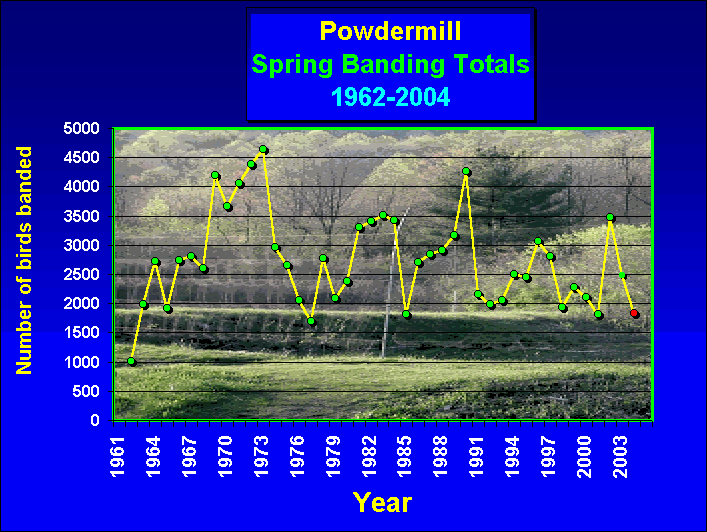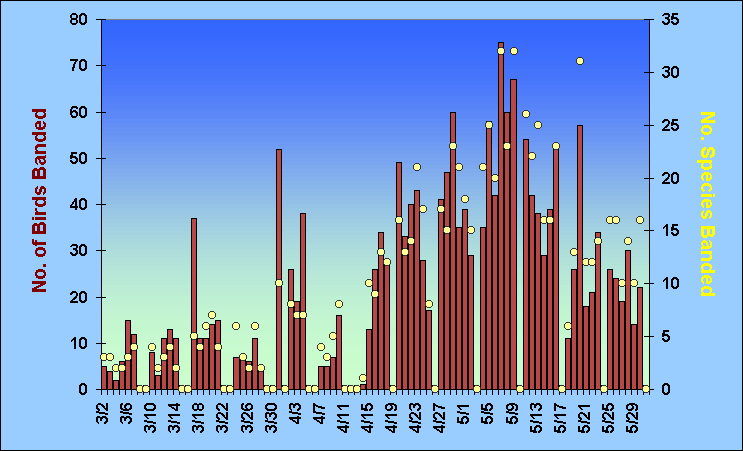
| The bird-banding
program at Powdermill
Nature Reserve, a 2,000 acre field biological station of Carnegie Museum
of Natural History located in the Laurel Highlands region of southwestern
Pennsylvania, was in operation on 70 out of a possible 91 days during the
spring 2004 season (March 2 through May 31). With a 42 year spring
average banding total of 2,567, and only 1,836 birds banded this spring,
we nearly set a new record low (nonetheless, this spring's total was just
within one stanbdard deviation of the long-term average). Only three
other years in the history of the program (third being 2001) had a lower
spring total than 2004, and only seven others were ever under 2,000 (Figure
1). Our spring season capture rate was
14 birds/100 net hours, possibly the lowest capture rate of all years (capture
rates have not yet been analyzed for all 43 years). While our total
just barely exceeded that in 2001, our capture rate was three fewer birds
per 100 net hours than in 2001.
Click
here to see
our 2001 season summary.
Weather this spring may have played a role in the lower than average totals--not only did rainy spring days delay or cancel banding on a few days, but also, warm summer-like weather persisted through much of April and May, forcing closing of nets well before noon on many days during the season. |
| Figure 1. Powdermill spring banding totals from 1962 through 2004. |

| It was an unusual spring for us in that no day exceeded 100 birds banded. In fact, our highest daily total was only 75 on May 7th, which tied May 9th for the most diverse day with 32 species of birds being banded (Figure 2). Nearly half of our catch on May 7th was wood warblers (14 species), two of which were were also the top catches for the day: Nashville Warbler (11) and Magnolia Warbler (8). Species diversity was just above average with a total of 100 species being banded, peaking the last week of April (18 new species added) and the first week of May (20 new species added). |
| Figure 2. Daily banding totals and species counts for spring 2004 at Powdermill Nature Reserve. Smaller graph shows the relationship between daily banding totals and daily species counts. |


| Ordinarily, it is not high diversity that results in high totals, but rather a handful of species making up a large proportion of our total catch. The table below gives the top ten species for this year compared to the top ten species and totals for the past 42 years grouped, for the most part, by decades. Dark-eyed Junco has long held the number one spot and the low overall banding total this spring can be somewhat attributed to the lack of any heavy migration of juncos through Powdermill--the same cause was implicated in the case of our low spring totals in 2001. Even during the years with the lowest cumulative totals for juncos (i.e. 1991-2003), Dark-eyed Junco averages per year were still about 250, or more than twice this spring's total. Comparing with the earlier years, nearly 5,000 juncos were banded in the 10-year periods, meaning an almost 500 birds represented an average spring catch. This serves to emphasize the impact this single, usually abundant species can have on our overall spring season totals. |
| Species | Spring Totals | Spring Totals | Spring Totals | ||||
| 2004 | Species | 1962-2003 | Species | 1991-2003 | |||
| Song Sparrow | 161 | Dark-eyed Junco | 15918 | Dark-eyed Junco | 2977 | ||
| Ruby-crowned Kinglet | 142 | American Goldfinch | 8514 | Ruby-crowned Kinglet | 2314 | ||
| American Goldfinch | 139 | Song Sparrow | 6982 | American Goldfinch | 2695 | ||
| Dark-eyed Junco | 109 | Ruby-crowned Kinglet | 5191 | Song Sparrow | 1617 | ||
| Gray Catbird | 72 | Brown-headed Cowbird | 4313 | Magnolia Warbler | 1400 | ||
| Magnolia Warbler | 72 | Evening Grosbeak | 3558 | Chipping Sparrow | 1230 | ||
| Cedar Waxwing | 67 | Field Sparrow | 3190 | Gray Catbird | 969 | ||
| Nashville Warbler | 60 | Magnolia Warbler | 2916 | Common Yellowthroat | 875 | ||
| Blue Jay | 59 | Chipping Sparrow | 2794 | Ruby-throated Hummingbird | 848 | ||
| Common Yellowthroat | 59 | Gray Catbird | 2708 | White-throated Sparrow | 798 | ||
| Spring Totals | Spring Totals | Spring Totals | |||||
| Species | 1981-1990 | Species | 1971-1980 | Species | 1962-1970 | ||
| Dark-eyed Junco | 4807 | Dark-eyed Junco | 4483 | Dark-eyed Junco | 3651 | ||
| American Goldfinch | 2636 | American Goldfinch | 2176 | Song Sparrow | 1621 | ||
| Pine Siskin | 2175 | Brown-headed Cowbird | 2071 | Field Sparrow | 1371 | ||
| Song Sparrow | 1846 | Evening Grosbeak | 1954 | Evening Grosbeak | 1202 | ||
| Brown-headed Cowbird | 1113 | Song Sparrow | 1898 | American Goldfinch | 1007 | ||
| Ruby-crowned Kinglet | 981 | Ruby-crowned Kinglet | 1155 | Ruby-crowned Kinglet | 741 | ||
| Purple Finch | 944 | Field Sparrow | 988 | Brown-headed Cowbird | 683 | ||
| House Finch | 886 | Cedar Waxwing | 879 | Chipping Sparrow | 638 | ||
| Magnolia Warbler | 826 | Purple Finch | 841 | Gray Catbird | 598 | ||
| White-throated Sparrow | 736 | White-throated Sparrow | 646 | Red-eyed Vireo | 566 |
| Totals for
all species banded
at Powdermill in spring 2004 are given in descending order in the table
below.
There were no rarities among the birds banded this spring, and overall no real "highlights". Only one bird neared a record high or low and that was Wood Thrush which tied the previous high total of 38. 161 Song Sparrows, the top bird for the season, was the highest total for that species since 1995. While not a record setter, with 13 banded, Blackpoll Warblers came in second this year to the 15 banded in the spring of 1990. No more than a handful are usually caught each spring, and this was the highest total for this species since 1990. While most individual species fell within 1 S.D. of the long term average in the table below, the majority were on the low end of that range. Only three were statistically 1 S.D. or more below the mean, including (not surprisingly) Dark-eyed Junco. Overall, we didn't experience any strong flights of Empidonax flycatchers or many wood warblers, two groups that also tend to help boost banding totals in years with good fallouts. In addition to the "misses" in the table below, however, we did have some "good gets" this spring (species with a long time average of <1). These included: Great Crested Flycatcher, Eastern Kingbird, Yellow-throated Vireo, Red-breasted Nuthatch, Orange-crowned Warbler, Blackburnian Warbler, Yellow-throated Warbler, and "Western" Palm Warbler. |
| Spring 2004 banding totals by species are given in decreasing order of abundance and compared to their long-term average (an "X" denotes if this spring's total is within, greater than, or less than one standard deviation, S.D., of the associated long-term mean). |
|
|||||||||||||||||||||||||||||||||||||||||||||||||||||||||||||||||||||||||||||||||||||||||||||||||||||||||||||||||||||||||||||||||||||||||||||||||||||||||||||||||||||||||||||||||||||||||||||||||||||||||||||||||||||||||||||||||||||||||||||||||||||||||||||||||||||||||||||||||||||||||||||||||||||||||||||||||||||||||||||||||||||||||||||||||||||||||||||||||||||||||||||||||||||||||||||||||||||||||||||||||||||||||||||||||||||||||||||||||||||||||||||||||||||||||||||||||||||||||||||||||||||||||||||||||||||||||||||||||||||||||||||||||||||||||||||||||||||||||||||||||||||
| In conclusion,
we
thank the following volunteers and interns who helped with banding this
spring: Randi Gerrish, Melissa Jakubcak, Brian Jones, Carroll Labarthe,
David Leibmann, Annie Lindsay, Felicity Newell, Iona Newell, Jim Sheehan,
Paul Sweet, Janice Sweet, and Sandra Terwilliger.
We also thank banders Tim and Rachel Dellinger from WVU and Steven and Caryl Baron from New York for their help while visiting the banding station. Valeria Ojeda, a PhD. student from Patagonia, Argentina, also spent many mornings during her 10 day stay at Powdermill helping to operate the banding station, as well as, contributing time in front of the computer entering molt data for us. Thank you! Finally, we owe huge thanks to Dan Hinnebusch, Mike Lohr, and Jake Mohlmann who were studying grassland birds this spring and summer for a Penn State graduate student but spent many of their days off at the banding lab helping out wherever needed and also contributed invaluable time and energy in helping us lay our grid points for the 3rd annual Bioforay plot this year. |
|
|
GO TO>
Last updated on 7/17/04
by Adrienne Leppold